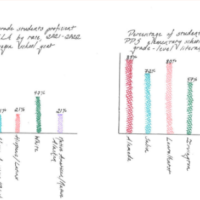
On May 23, 2023, over 700 educators, janitorial staff, nutritionists, paraprofessional educators, students, parents and community members filled the Dr. Matthew Prophet Education Service Center. Overflowing into the parking lot, they came together to advocate for one common
goal: a budget that includes a living wage for all staff within the Portland Public Schools (PPS) district.
The PPS budget is an annual plan outlining the district’s allocation of finances and investments for the upcoming fiscal year, and it is what PPS employees are looking to change.
The PPS Board of Education’s Community Budget Review Committee (CBRC) began discussing the PPS budget in November 2022, starting a roughly nine-month-long conversation that tackled how the allotted money could best serve educators, students and others within the district.
During the budget planning period, the CBRC engaged with groups and community members across the district to gather input. This information was then used to make recommendations to the PPS Board of Education on how to best allocate resources in order to achieve the district’s desired outcomes.
The board released an overview of PPS’ goals in June 2022, stating, “The proposed Board Goals represent a rigorous set of benchmarks along the Pre-K to 12 academic continuum that will allow us to gauge student progress towards realizing the promise of the Graduate Portrait.” The Graduate Portrait outlines what the community wants its students’ education to look like and how PPS can best prepare them to thrive in their future endeavors.
In late spring, the budget was placed in the hands of the PPS school board, who then approved and adopted it at a board meeting on June 13, 2023.
Nearly two months prior, the superintendent’s budget, which was constructed with information from the CBRC, was presented to the PPS school board on April 25, 2023. It was met with myriad concerns from educators and community members in the district.
Amy Silvia, who spoke on behalf of the Service Employees International Union at a board meeting discussion, said, “The proposed budget cuts 10 custodial positions while adding administrative positions. Cutting 10 custodial positions will lead to more burn out, more turnover and dirtier schools.” Silvia demanded that the district “pay (staffers) living wages.”
Silvia’s request was echoed throughout the meeting, as educators and union members expressed their concerns regarding the proposed budget.
The initial budget was based on a $9.9 billion statewide education fund proposed by Oregon’s Joint Committee on Ways and Means, made up of both Senate and House members. Following the proposal of the PPS superintendent’s budget, hundreds of educators went to Salem, and hundreds more called and emailed their legislators to lobby for an increase in statewide school funding. The calls were answered with an additional $300 million, bringing the statewide funding to $10.2 billion. “It turned out that we got $10.2 billion, which is great, but still not enough to maintain current service levels,” says Junho Chang, the senior budget manager of PPS. Oregon’s Quality Education Model for 2021–2023 determined that a budget of $11.16 billion would be needed to fully fund the model. Chang says, “To provide that Quality Education Model would require $11.16 billion for the budget. So that tells you even more how much of a gap we have.”
In addition to the supplementary state funding, the ending fund balance from the 2022–2023 fiscal year created additional revenue of around $10.3 to $10.4 million for PPS that carried over into this year. According to Chang, some of the additional funding went back into places that were reduced to balance the initial budget. A percentage was reallocated to cover additional costs and hours for staffing, and the district was able to reinstate a few campus security agents and custodial full-time employees. Several restorative justice coordinators were instated as well.
“These changes were made mostly based on the feedback we received from the board, the CBRC, through the public hearings, through the student representative on the board (Byronie McMahon) (and) through the union representatives,” says Chang. “They all had feedback that had an impact on the revisions that were made.”
The conversation regarding how the additional statewide funding will be spent remains ongoing. PPS’ portion of the funding is about $15 million for the current fiscal year. The district touched base with the CBRC to alter the budget so it considers community recommendations. According to Chang, the budget will be finalized shortly.
Although the PPS district budget came in at over $2.17 billion, the Portland Association of Teachers (PAT) does not believe it is enough
and is calling for more funding. PPS Board Chair Andrew Scott furthered this notion, saying, “I just want to make sure that we don’t pretend what Salem is doing is somehow fully funding education. They are not.”
The PPS superintendent, Guadalupe Guerrero, addressed the lack of state funding in his budget message addressed to the PPS community: “State revenue is not keeping up with the cost of operating our schools, and our students’ needs continue to grow.”
The adopted budget includes a Racial Educational Equity Policy that establishes six goals the district intends to achieve relating to maintaining racial equity in education. “That is almost the entire basis for our staffing formula — to make sure that it is equitable,” says Chang.
Equity Funding, which makes up 8% of the total funding for instructional staff, allocates additional resources to schools in need. Every school in the district receives a two-part Equity Funding allocation based on the Socio-Economic Status (4%) and Combined Historically Underserved population (4%) of their student body. Schools with a higher concentration (more than 40%) of historically underserved students are eligible for the Combined Historically Underserved funding.
Angela Bonilla, the president of the PAT, expressed uneasiness about the policy. “The concern is that we still have Black and Indigenous kids in other schools, and what supports are being provided for them if all of the energy and money is literally being pulled from some sites to go to other sites?” she says. “All of our kids are hurting. How do we support all of our kids, and then how do we make sure that it is culturally responsive and specific for our kids who have been ignored and marginalized?”
Her solution is clear: “Our stance has always been, increase it for everyone, and for those who need more, give more. That’s where
real equity is.”
“At a certain point, the staffing formula isn’t perfect,” says Chang in response to concerns about the policy. “What it does do is provide those additional supports where they are most needed. That is, based on the demographics of any given school.”
In a public comment at the May 23, 2023, board meeting, Bonilla stated that the budget proposed a decrease in licensed staff by 8%. The current mental health crisis has led many to question why the number of district teachers and counselors — the staff members who can provide the most direct support and care to students — is declining in this proposal.
“At a PFSP (Portland Federation of School Professionals) training, district management told classified staff that we are the glue that holds schools together,” says Madeline Parvankin, an Educational Assistant (EA) at Astor K-8. “The next week I learned that all the EA jobs, including my own, were cut at my school.”
The CBRC reported that the district and the school board must recognize how non-student facing positions have increased by 7% since 2020, while class certified student facing positions have decreased since 2020, according to Bonilla. Instead of increasing the pay and number of positions available to PAT and PFSP members, Bonilla says, “The Community Budget Review Committee made it clear that when the funds are available, they are increasingly spent on increased management … The reality is, they are cutting the folks doing the service and are increasing the administrators in office.”
Bonilla advised the board, and the district as a whole, to listen to its students and educators. “Do not remove students from the equation when we are talking about student needs,” she says. “You can’t say we are student centered if you take them out of the equation.”
Educators across the district have made it abundantly clear that they do not want to strike — they want to work. Yet, to show up for their students, educators demand the district show up for them by increasing their wages in the 2023–2024 PPS budget. In her closing statement to the school board, Parvankin made that clear: “We will not remain invisible. We need a raise, we need our jobs and you need us.”




